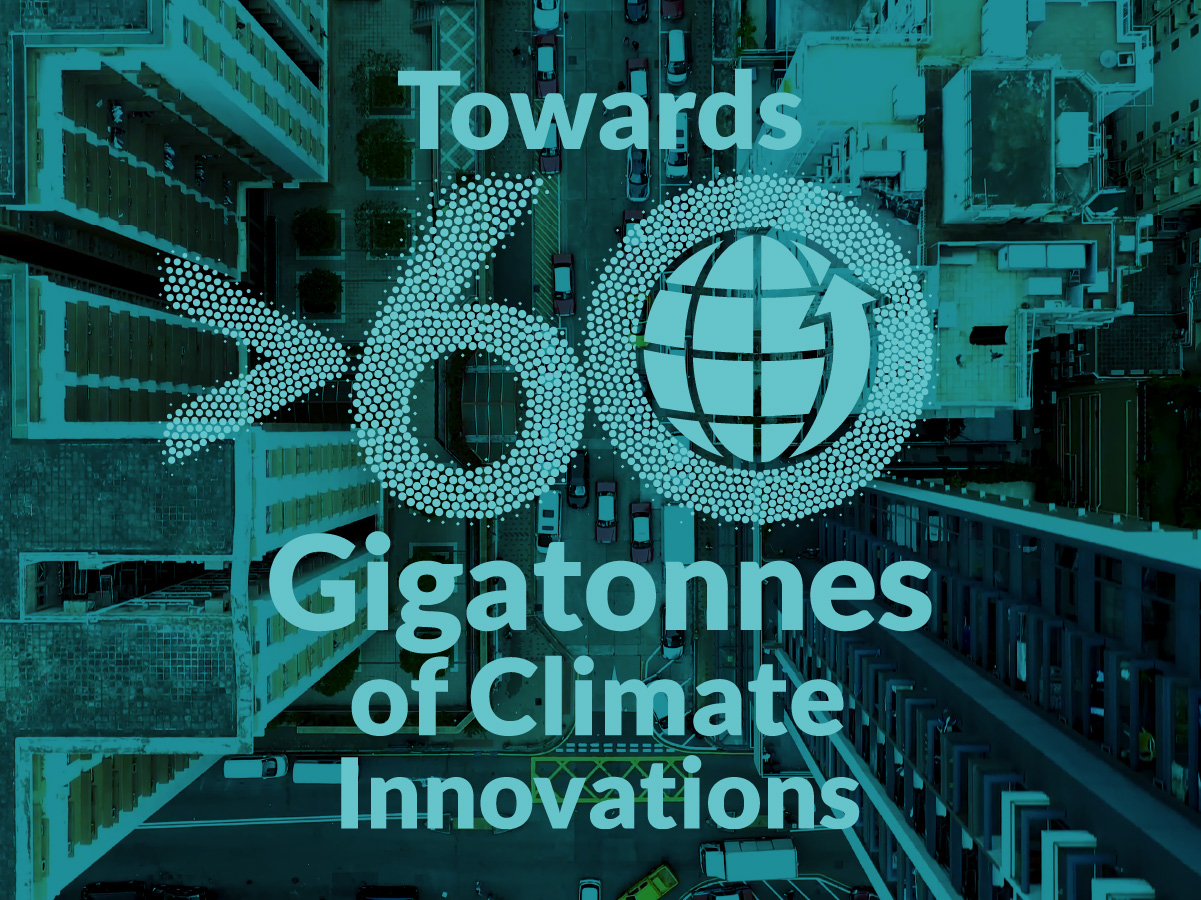Nominated innovations
1000 innovative clean energy solutions and > 150 framework enablers with the potential to deliver more than twelve gigatonnes of avoided emissions by 2030
These assessments are based on a basic avoided emission assessment. The overall concept of avoided emissions is that a solution (product or service) enables the same function to be performed with significantly less GHG emissions. The method of measuring avoided emissions, is to compare a baseline scenario without the enabling solution, with a scenario using the enabling solution; whereby the baseline represents the ‘business as usual’ (BAU) scenario.
These assessments are based on the framework document: The Avoided Emissions Framework (AEF) from September 2020

Desert Restoration
Desert Restoration wrote: Using allan savory’s holistic management (hm) and holistic planned grazing (hpg) systems we intend to turn desert land into lush grasslands in a sustainable system that employs large livestock to restore the land, sequester massive amounts of co2, and break down methane. Produce from such ranches are one of the only types of animal produce that do not add to the climate change catastrophe, as a matter of fact, they present one of the most promising solutions to it. It’s not the cow, it’s the how. Climate friendly produce is labelled and marketed accordingly. This system mimics nature and relies on only natural means... Source: EIT Climate KIC's Climathon
Sudan

Desert Restoration
Desert Restoration
Desert Restoration wrote: Using allan savory’s holistic management (hm) and holistic planned grazing (hpg) systems we intend to turn desert land into lush grasslands in a sustainable system that employs large livestock to restore the land, sequester massive amounts of co2, and break down methane. Produce from such ranches are one of the only types of animal produce that do not add to the climate change catastrophe, as a matter of fact, they present one of the most promising solutions to it. It’s not the cow, it’s the how. Climate friendly produce is labelled and marketed accordingly. This system mimics nature and relies on only natural means... Source: EIT Climate KIC's Climathon
Currently unavailable

Diluteze
Diluteze wrote: Diluteze develops products that aid & protect people when working with potentially hazardous chemicals in the workplace, home or garden (e. G. Weed killers & detergent for example), achieving this with sustainable products that reduce the environmental impacts of potentially harmful chemical products, product that do nonetheless protect our crops and sterilize our hospitals... Source: EIT Climate KIC's ClimateLaunchPad
Ireland

Diluteze
Diluteze
Diluteze wrote: Diluteze develops products that aid & protect people when working with potentially hazardous chemicals in the workplace, home or garden (e. G. Weed killers & detergent for example), achieving this with sustainable products that reduce the environmental impacts of potentially harmful chemical products, product that do nonetheless protect our crops and sterilize our hospitals... Source: EIT Climate KIC's ClimateLaunchPad
Currently unavailable

Dispersa Inc.
Dispersa Inc. wrote: At dispersa, we are harnessing the power of microbes to present low-cost, 100% biodegradable, and versatile specialty chemicals, such as surfactants, used in a variety of industrial applications... Source: EIT Climate KIC's ClimateLaunchPad
Canada

Dispersa Inc.
Dispersa Inc.
Dispersa Inc. wrote: At dispersa, we are harnessing the power of microbes to present low-cost, 100% biodegradable, and versatile specialty chemicals, such as surfactants, used in a variety of industrial applications... Source: EIT Climate KIC's ClimateLaunchPad
Currently unavailable

Dispo
Dispo wrote: Coming from the above mentioned situation, dispo is the idea of a technology that could reduce the volume of the already generated waste down to only 10% of the original volume. As result, it will reduce the number of visits of the waste transport vehicles and aconsequently reduce the service fees and the co2emissions associated with the process. Such technology already exist in the markets at bigger sizes for the waste to energy power plants, as it improves the calorific properties of waste based fuels. But till now does not exist for kitchen or building sizes . Dispo will be designed in different sizes 1- kitchen size that could treat 5 kg/day of house/office use... Source: EIT Climate KIC's Climathon
Germany

Dispo
Dispo
Dispo wrote: Coming from the above mentioned situation, dispo is the idea of a technology that could reduce the volume of the already generated waste down to only 10% of the original volume. As result, it will reduce the number of visits of the waste transport vehicles and aconsequently reduce the service fees and the co2emissions associated with the process. Such technology already exist in the markets at bigger sizes for the waste to energy power plants, as it improves the calorific properties of waste based fuels. But till now does not exist for kitchen or building sizes . Dispo will be designed in different sizes 1- kitchen size that could treat 5 kg/day of house/office use... Source: EIT Climate KIC's Climathon
Currently unavailable

Reduction of losses in distribution grids
Dlaboratory’s solution register and visualizes incidents in the electrical grid, allowing identification and reaction to faults in the grid. This is done through monitoring of the distribution grid, where, according to Dlaboratory, most of the interference takes place. The collection of real-time data is then combined with an algorithm which analyses and categorizes events and generates a recommend course of action for the user. This solution can both help in reducing the number of incidents which lead to significant energy losses while also reducing the cost for operation and maintenance.
Sweden

Dlaboratory Sweden AB
Reduction of losses in distribution grids
Dlaboratory’s solution register and visualizes incidents in the electrical grid, allowing identification and reaction to faults in the grid. This is done through monitoring of the distribution grid, where, according to Dlaboratory, most of the interference takes place. The collection of real-time data is then combined with an algorithm which analyses and categorizes events and generates a recommend course of action for the user. This solution can both help in reducing the number of incidents which lead to significant energy losses while also reducing the cost for operation and maintenance.
Currently unavailable

Dockit - "Love Food...Hate Waste"
Dockit wrote: Dockit aims to develop innovative software solutions to everyday restaurant problems, in particular, food waste. . - roughly 50% of food waste can be attributed to labour i. E. Human error. - 1 tonne of food waste equates to 2 tonnes of co2 equivalents. - food waste accounts for between 3-5% of total running costs in restaurants. . Dockit aims to significantly reduce the climate impact of food waste by tackling the issue of incorrect ordering in restaurants because "small changes can make a big difference"... Source: EIT Climate KIC's ClimateLaunchPad
Ireland

Dockit
Dockit - "Love Food...Hate Waste"
Dockit wrote: Dockit aims to develop innovative software solutions to everyday restaurant problems, in particular, food waste. . - roughly 50% of food waste can be attributed to labour i. E. Human error. - 1 tonne of food waste equates to 2 tonnes of co2 equivalents. - food waste accounts for between 3-5% of total running costs in restaurants. . Dockit aims to significantly reduce the climate impact of food waste by tackling the issue of incorrect ordering in restaurants because "small changes can make a big difference"... Source: EIT Climate KIC's ClimateLaunchPad
Currently unavailable

Copper restoration system
The technology uses copper-based and nickel-based nanocomposites to remanufacture copper base material. The target of the technology is primarily for continuous casting mouldings. Wear layers in the mould are resistant, but eventually become obsolete after repeated use. The wear layers of the moulds can be improved by the applications of the nanocomposites, reducing the amount of wear and thus, the waste from the casting process.
China

Dong He Advanced Material Technology Ltd
Copper restoration system
The technology uses copper-based and nickel-based nanocomposites to remanufacture copper base material. The target of the technology is primarily for continuous casting mouldings. Wear layers in the mould are resistant, but eventually become obsolete after repeated use. The wear layers of the moulds can be improved by the applications of the nanocomposites, reducing the amount of wear and thus, the waste from the casting process.
Currently unavailable

City-integrated bike sharing platform
Donkey Republic developed and deployed a hub-centric bike sharing platform. The hub-centric model uses designated parking locations for the pick-up and drop-off of rentable bikes. A hub is defined by the GPS coordinates of a point and a radius (e.g. 10 meters) around that point within which riders can drop off a bike. This allows local authorities to control the use of public space, easily monitor locations and influence fleet distribution and growth. Users can count on bikes being available at specific locations. The Donkey Republic system is enabled by the communication between a mobile app and an electronic ring lock placed on the bike, via a low energy Bluetooth connection.
Denmark

Donkey Republic
City-integrated bike sharing platform
Donkey Republic developed and deployed a hub-centric bike sharing platform. The hub-centric model uses designated parking locations for the pick-up and drop-off of rentable bikes. A hub is defined by the GPS coordinates of a point and a radius (e.g. 10 meters) around that point within which riders can drop off a bike. This allows local authorities to control the use of public space, easily monitor locations and influence fleet distribution and growth. Users can count on bikes being available at specific locations. The Donkey Republic system is enabled by the communication between a mobile app and an electronic ring lock placed on the bike, via a low energy Bluetooth connection.
Currently unavailable

Microgrid monitoring and optimisation
The innovation is a smart meter that will enable better end-to-end use of solar micro grids. It includes a monitoring system, working with measuring nodes on various parts of the micro grid, that give the user better understanding of the micro grid’s current state. The monitoring system identifies potential issues in the grid so that preventive action can be taken. The system also improves the uptime of the micro grid and thereby the quality of the supply. The smart analytics will help improve the distribution of energy resources within the micro grid.
India
≲0.1

Doorastha Analytics Pvt. Ltd.
Microgrid monitoring and optimisation
The innovation is a smart meter that will enable better end-to-end use of solar micro grids. It includes a monitoring system, working with measuring nodes on various parts of the micro grid, that give the user better understanding of the micro grid’s current state. The monitoring system identifies potential issues in the grid so that preventive action can be taken. The system also improves the uptime of the micro grid and thereby the quality of the supply. The smart analytics will help improve the distribution of energy resources within the micro grid.
≲0.1Mt CO2e/year

Double capacity of first generation EVs
DoubleEV wrote: In year 2010 nissan started to sell first truly ev for masses - nissan leaf, and as of today - around 300k cars were sold. First version of these car bears 24kwh battery, with real world range around 140-150 km per charge. As battery pack capacity decreases over time - there will be moment for ev owners to consider either buying new car or new battery pack. We plan to offer battery pack upgrade using modules built from densier cells (type 18650) to double capacity of battery pack up to 48kwh... Source: EIT Climate KIC's ClimateLaunchPad
Latvia

DoubleEV
Double capacity of first generation EVs
DoubleEV wrote: In year 2010 nissan started to sell first truly ev for masses - nissan leaf, and as of today - around 300k cars were sold. First version of these car bears 24kwh battery, with real world range around 140-150 km per charge. As battery pack capacity decreases over time - there will be moment for ev owners to consider either buying new car or new battery pack. We plan to offer battery pack upgrade using modules built from densier cells (type 18650) to double capacity of battery pack up to 48kwh... Source: EIT Climate KIC's ClimateLaunchPad
Currently unavailable